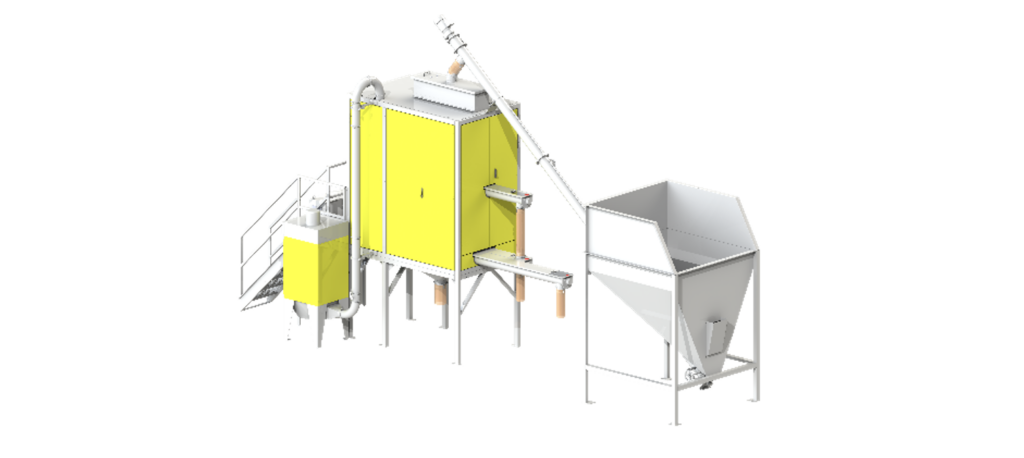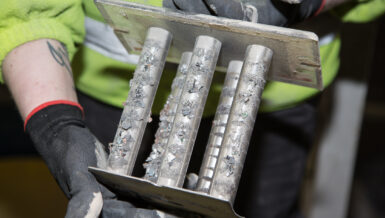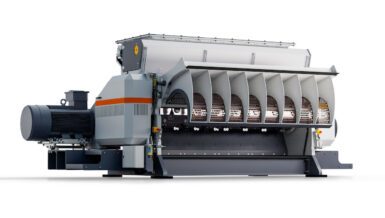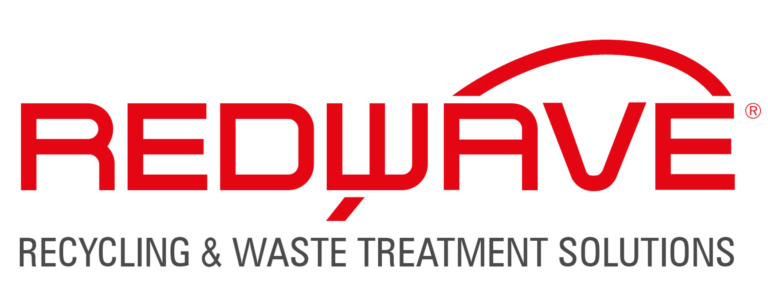One of the main targets is that 25% of the plastics used in new cars should come from recycled materials, a quarter of which should come from End-of-life vehicles. In total, 30% of plastics from scrapped vehicles are to be recycled, compared to only 19% today.The regulation requires car manufacturers to provide dismantling facilities with detailed instructions for the replacement and removal of components at the End of a vehicle’s useful life. The average car contains between 150 and 200 kg of plastic.The measures would reduce carbon emissions by ~12.3 million tons annually by 2035, according to the Commission. It estimates that the scheme will lead to net revenues of 1.8 billion euros by 2035.
Hamos GmbH is a manufacturer of recycling and separation systems for the unmixed processing of various hard plastics from automotive shredder residue.
When vehicles are shredded, a valuable metal fraction consisting of ferrous and non-ferrous metals is produced on the one hand. On the other hand, the so-called “shredder light fraction” is obtained, in which all other materials such as plastic bumpers, seat upholstery, dashboards, headliners and much more are present in shredded form. In addition to these products, there is also a considerable proportion of rubber, which comes from the car tires that are sometimes shredded together with the car body. The hard plastic fractions produced after separation of the “light fraction” still contain the unwanted rubber pieces from shredded tires. Some of these rubber pieces are in the same density range as the thermoplastics and therefore cannot be separated using density separation processes.
To separate this rubber fraction, which is at least semi-conductive due to the high proportion of carbon black, hamos KWS electrostatic separators are used. Most of the rubber fraction is separated together with other conductive products (e.g. wet wood!). The remaining hard plastic is then virtually rubber-free. Through a subsequent combination of wet and dry processing methods, pure fractions such as ABS, PS and PP can be produced from such mixed plastics. However, even if these shredder fractions are sent “unsorted” for thermal recycling, it makes sense to separate out as much rubber as possible in order to reduce the undesirable sulphur content during incineration.

Problems with elastomers
What all types and grades of rubber have in common is that they are thermosets, i.e. they do not melt in the plastic melt during the further processing of plastic recyclates. They therefore do not bond or fuse with the actual plastic product and lead to holes, tool damage and much more in the finished part.
With modern melt filters, which are installed at the End of an extruder, a certain proportion of the elastomers can be filtered out of the plastic melt. The overall system, consisting of the extruder with the correct melt temperature, the correct pressure in the extruder and the filter fineness of the downstream melt filter, plays a major role in this. However, if these parameters are set incorrectly, if the percentage of rubber in the regrind is too high or, for example, the pressure in the extruder is too high, the elastomer pieces are simply forced through the melt filter by the high pressure and end up in the pellets or in the finished product. Even the smallest impurities of rubber in the regrind are enough to make a product or an extruded recyclate completely or partially unusable. This means that the clean and complete separation of the elastomer fraction from plastic regrind is a decisive step in achieving clean plastic fractions.
Separation options for rubber particles
hamos GmbH from Penzberg has developed various processes to separate such “rubber fractions” from shredded plastic regrind. All processes work optimally if the regrind is in the particle size range < 10 mm and has been carefully dedusted beforehand.
Conductive elastomers
Many elastomers are filled with carbon black or colored black with pigments made from carbon black. This so-called ‘carbon black’ is the most widely used additive in tires, for example.
When separating the rubber fraction from the plastic, use is made of the fact that particles filled with carbon black are electrically conductive, while the plastics themselves consist of non-conductors. It should be noted that both rubber and certain plastics sometimes have the same specific weight and therefore density separation methods are not successful. Color sorting does not work either – everything is black!
However, electrostatic separators can be used to separate conductors from non-conductors. The rubber-containing plastic regrind is fed onto a rotating separation roller and charged in an electric field via a high-voltage electrode. The discharge of the particles on the grounded separation roller then depends on the conductivity of the products. Good conductors such as soot-filled rubber particles discharge very quickly and fall off, while plastics as good insulators discharge very slowly and are separated elsewhere. Such electrostatic separators are widely used in the recycling industry. Standard devices can separate the rubber fraction from up to 1,800 kg/h of “contaminated granulate”.

Non-conductor-non-conductor separation
Things become more difficult when both the rubber and the plastic regrind consist of non-conductive materials. In this case, the electrostatic plastic-plastic separators do an excellent job. A special charging device within the device charges the plastics positively, for example, while rubber and other elastomers are charged negatively. Separation then takes place in an electrode system that works with high voltage. Positively charged particles are attracted by a negative electrode, for example, and vice versa. Standard devices separate up to 1,000 kg/h, higher throughputs can be achieved by connecting several devices in parallel.
Separation of foams, silicones, etc.
A number of rubber types, silicones and foamed rubbers cannot be separated using conventional separation technology. The hamos rubber separation systems utilize different physical parameters between plastic and rubber for separation.
The hamos RSS separator separates approx. 75 – 95 % of the interfering rubber fraction by dry means. Throughputs of up to 1,000 kg/h are easily possible with standard devices.
Recycling of removed car parts
Dashboards
Electrostatic separation technology is suitable for recycling dashboards. In the production of cockpits and instrument panels for cars, up to 20 percent of waste is generated. These are essentially high-strength carrier materials such as SMA with glass fiber reinforcement, coated with PU foam and a “cover skin” made of PVC or PU, for example. SMA in particular is a very high-quality and expensive plastic that should be recycled for economic reasons alone so that the valuable plastics are not lost. The problem here, however, is that in most cases all three plastics – SMA, PU foam and top layer – are colored black.
The production waste is shredded and ground in a granulator. Due to the friction in the mill, the PU is almost completely separated from the SMA and PVC and can then be easily separated by air separation. The mixture of black SMA with black PVC is now separated electrostatically. The achievable purity of the SMA is over 99.5 percent. This purity is so high that this product can be incorporated directly into new dashboards (picture 3). Due to its high purity, soft PVC can also be incorporated into new products without any problems.

Functional parts in cars
Parts of ventilation and air conditioning systems in cars that are not directly in the passengers’ field of vision are made almost 100 percent from black plastics. Various technical plastics are used for functional reasons. Composite materials are also frequently used, for example by injecting an elastic sealing lip made of TPU or EPDM onto a ventilation flap made of glass fiber-reinforced PP. When recycling production waste, these impurities from the rubber lips cause major problems and prevent the recyclate from being reused.
When the materials are ground in a granulator, the rubber lip is almost completely detached by the friction inside the granulator. The ground material is dedusted and then separated electrostatically. The result is a highly concentrated PP fraction. The black color of both the functional parts and the EPDM seals is irrelevant.
To summarize, the separation technologies developed by hamos make it possible to produce high-quality plastic recyclates from the complex ASR mixtures, which can then be reused in the production of new plastic parts.
One of our most experienced customers in this area is Galloo Plastics. Based in France and part of the Galloo group, the company is a reference in closing the loop from shredder residue from end-of-life vehicles (ELV) to recycled polypropylene for automotive applications. As a market leader, polypropylene grades from Galloo Plastics are used by various equipment manufacturers for the injection molding of new car parts.
























